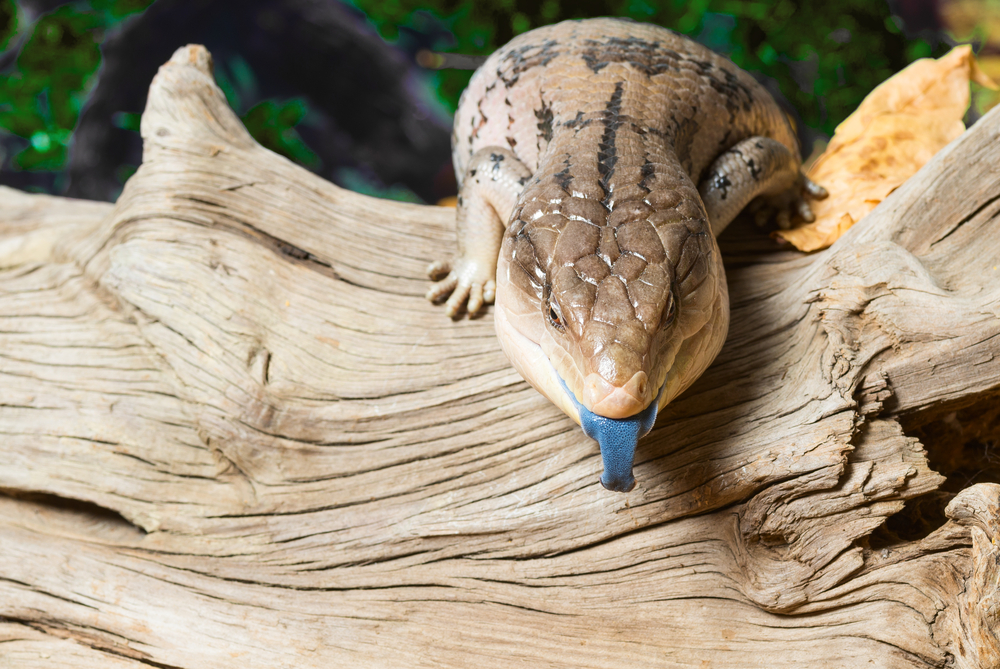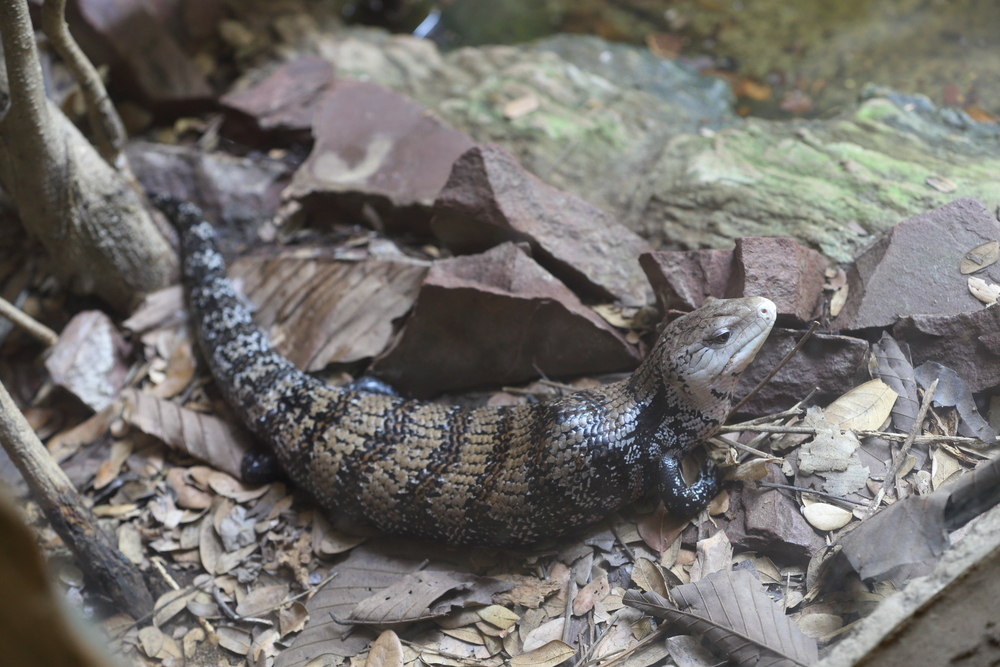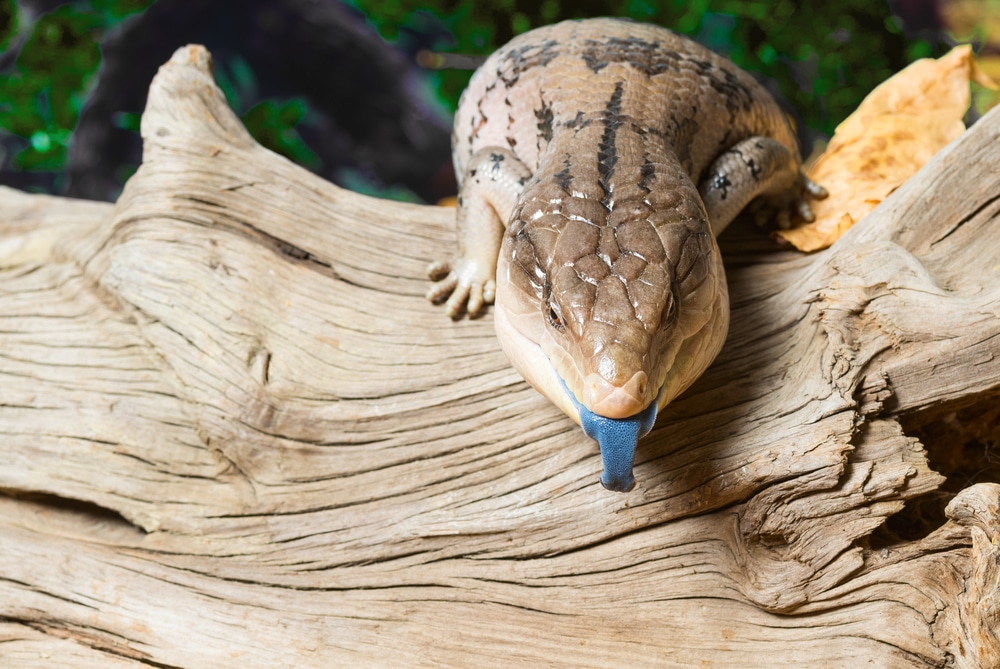Blue-tongued skinks very sturdy, with tough bodies that are stouter than other lizards.
Are you thinking of acquiring a blue-tongued skink for a pet? Blue tongues have many fans, due in no small part to the beautiful namesake tongue. Adults average 18 to 22 inches in length, and they make amazing pets and are great for kids because they are so easily handleable. They have smooth, shiny scales and firm bodies (unlike bearded dragons, iguanas, uromastyx and other pet lizard species that generally have softer skin), which makes them a bit easier to hold. They’re very sturdy, with tough bodies that are stouter than other lizards, and which can withstand the firm grip of a child.
Depending on the species, blue tongues come from Australia and Indonesia. There are exceptions, but generally the Australian blue tongues are subspecies of Tiliqua scincoides and the Indonesian types are T. gigas subspecies. The Australian skinks are commonly available from private breeders; the Indonesian types are still imported, and it is those you are more likely to see in pet stores. Remember, it’s always preferable to obtain captive-bred animals.

SHUTTERSTOCK/LESPalenik
Blotched Blue-tongued skink (Tiliqua nigrolutea).
Blue tongues have tiny little legs and feet, so they aren’t going to go anywhere fast. Adding to their appeal, in addition to their beautiful namesake tongues, are their very personable eyes. When you approach a blue-tongued skink, you can actually see the lizard looking at you. This eye contact is not possible with many reptiles, including certain snakes and geckos, and I believe it helps develop a bond between skink and owner. I honestly believe that blue-tongued skinks can learn to recognize their owners.
Handling is important, and the best way to get to know your pet skink is to hold it often. Let it wander around outside its cage, hand-feed it, lay it on your chest and let it watch TV with you. Have fun! The key word is “interaction.” If you do this, you will soon have a very lazy, tame and friendly skink.
Blue-tongued Skink Care Basics
A single adult blue tongue should be kept in, at a minimum, an enclosure measuring 3 feet long by 18 inches wide (a common size available at pet stores). That said, the more space, the better. Smaller enclosures are okay for babies and juveniles, but remember that they will grow incredibly fast, so you may as well start with a permanent adult enclosure rather than have to upgrade from a smaller one a few months later. Remember that floor space is key, not height, because blue tongues are terrestrial ground-dwellers, not tree climbers. One look at their short, stubby legs will tell you that!
A tight-fitting screen top will allow proper air flow and protect your skink by providing a barrier between it and the heat lamp on top of the enclosure. Of course, it will also prevent the animal from climbing out, and other creatures, including cats, mice and even spiders and other insects, from getting in.
You will need to provide a temperature gradient by placing an incandecent heat lamp at one end of the enclosure. The proper temperatures for a blue-tongued skink are 70 to 80 degrees on the cool end, and 90 to 100 degrees on the hot end. A digital temperature gun works best for determining exact temperatures.
Read More
Create a basking site directly beneath the heat lamp. I like to use simple ceramic kitchen tile, particularly dark-colored tiles that will absorb heat (avoid any with a glossy finish). They are inexpensive and you can cut or break them into any shape, though beware excessively pointy or jagged edges. Slate is also excellent. Remember, your blue tongue needs a flat, smooth basking surface that is large enough to accommodate its entire body.
The heat lamp should be on eight to 12 hours during the day. Do not use hot rocks, and heat mats or tape are also unnecessary; a good lamp will be sufficient. Turn the heat lamp off at night.
Blue tongues are diurnal, which is another great bonus if you have children, because they can keep the lizards in their rooms without concern that their sleep would be disrupted by the sounds of a nocturnal pet. Blue tongues require a natural cool-down period and do not need to be heated around the clock. Full-spectrum UV lighting can be provided by placing a fluorescent tube over the screen top on a 12 hours on/off cycle.
The terrarium bedding can be almost any type of substrate you find at the pet store except cedar chips/shavings and sand. The constant exposure and strong aroma of cedar can be unhealthy for your pet, and sand can cause an intestinal impaction if the animal gulps down too much while eating. Spot clean daily, and be sure to remove and replace any surrounding substrate along with the actual fecal matter. We use simple toilet paper to spot clean.
Generally, the terrarium should be completely cleaned out every month. Using a shop-vac to clean out old substrate makes the job a cinch. After the old substrate is out, simply wipe everything down with an anti-bacterial soap and warm water, rinse, then disinfect with a bleach/water solution. Just be sure the tank is completely free of fumes and any strong bleach scent before placing your skink back inside.
Clipping Nails Is Not Optional!
If your blue tongue has fast-growing nails, it’s very important that they are clipped regularly. Otherwise, they will begin to curl inward, making it nearly impossible for your pet to walk without hurting and possibly injuring its toes. Some blue tongues have nails that don’t seem to grow, others actually seem to lack toenails, but most blue tongues have nails and it’s important that they be kept trimmed. Neglecting your skink’s toenail length and general “toe health” will lead to toe breakage and toe loss.
Standard human fingernail clippers can be used to clip your blue tongue’s nails, though larger toenail clippers are easier to hold and maneuver. Be sure to sterilize them before use. Use extreme caution and be very careful not to clip off an entire toe if your pet starts squirming. Be careful, too, that while you’re focusing on clipping one toe, another doesn’t slip into the clipper unnoticed. It is key is to take your time.
Carefully clip off about half of the toenail (never the entire nail!). If your skink starts squirming while having its nails trimmed, try placing a baby sock over its head. I will place a bluey at the end of a coffee table and clip its nails while it’s sitting there contemplating whether or not it wants to jump. Of course, two people make nail clipping easier, with one person holding the animal and the other doing the clipping.
Don’t panic if there is a little blood after a nail clipping. Do not place your blue tongue immediately back into its cage, and don’t take it outside. To do so could risk bacteria entering even a small wound. Instead, place the lizard on clean, dry paper toweling until the bleeding stops.
Blue-tongued Skink Food
Blue-tongued skinks are omnivorous, meaning they eat both plant matter and meat protein. We use a very loose 50/40/10 system: 50 percent vegetables and greens, 40 percent meat and 10 percent fruit.
Fresh greens are important and may include kale, collard greens, mustard greens, beet greens, bok choy, etc. Any fruit is fine, including figs, papaya, mango, grapes, banana, diced apple, strawberry, blackberries, raspberries, blueberries, melons and kiwi. Meats can include cooked (avoid raw), shredded/ground lean chicken, beef or turkey, different types of worms and insects, an occasional mouse, and a small amount of dog food (high-quality, wet dog food is optimal; low-quality, cheap pet food typically contains by-products as the number one ingredient, while high-quality wet dog foods often contain mostly whole meats and vegetables). Avoid avocado, rhubarb, mushrooms, and seafood.

shutterstock/wannasak saetia
A single adult blue tongue should be kept in, at a minimum, an enclosure measuring 3 feet long by 18 inches wide (a common size available at pet stores).
Blue tongues can generally be fed every two to three days, but switch to once a week if you notice yours is gaining a lot of weight. These skinks are not very active in captivity, so it is easy for them to become overweight if they are fed too much.
If you notice your skink is losing its appetite during the winter months, don’t worry, this is normal. It may even cease to eat completely during the winter; regular eating habits should resume in the spring. Even if your blue tongue doesn’t seem interested in eating, though, always offer food and always keep fresh water available. Water can be offered in a large pie or casserole dish, and it should be changed every other day unless soiled.
Blue-tongued Skink Gender Identification
Many tips for sexing blue tongues have been passed down over the years, such as males will often have larger, bulkier and more triangular heads, a thicker tail base, slimmer sides, a huskier throat and brighter orange eyes than females. However, none of these identification methods are 100-percent accurate.
A skink with a large head and orange eyes might be a male, but not always. In regard to eye color, I’ve seen brown, orange and everything in between on both males and females. Generally, males do tend to have bulkier heads than females in comparably sized and analogous species, but when it comes to sheer body size, males are not always bigger than females or vice versa. Naturally, if you have a very large female, she will likely have a very large head, and if you have a very small male, he might have a very small head. Sometimes head size is disproportionate to the rest of the body, and if a male was malnourished during his crucial first year, his growth may have been stunted. There is no concrete rule regarding size versus sex.
Slimmer sides, too, are supposed to indicate a male, but this identification method is grossly inaccurate because a large number of captive-bred pets, both male and female, are pleasantly plump.
Diet plays a large role in the shape and size of a blue tongue. Besides, what are “slim” sides, exactly? Slim is a subjective term. A “huskier” throat is also said to indicate a male, but throat size can vary among the sexes along with the rest of the body size.
The male hemipenes are fairly large, and when they are tucked away in the general area of the base of the tail, sometimes their sheer mass can push on the inside walls of the tail, creating a bit of a bulge. But again, a thick tail base does not guarantee a male because fat is stored in the tail. What you may identify as a possible male with a thick tail base could very well be a healthy female with plenty of stored fat.
So how can you positively identify the sex of your skink? During the winter months and into spring, male blue tongues will occasionally drop a “sperm plug,” sometimes by itself, other times with excrement. They resemble two stringy, mucous-covered strands that are about an inch long and translucent. They can be harder to see on certain substrates that may camouflage plugs or absorb them almost immediately; they are easiest to spot on a substrate of artificial turf.
In males as young as 3 months of age, it is possible to witness their hemipenes popping out during defecation or urination. Some males will display the hemipenes nearly every time, others hardly ever. But if you are lucky enough to see them, you know you have a male!
You can also determine gender by placing animals together and observing how they react to each other, especially if you have two that you are hoping to breed. For the best results, experiment with this during the spring.
Male behavior may include a complete halt in movement; a male will likely freeze for up to 30 seconds or more before bolting toward a female. Males will also bite onto the other animal and hold on. If this is not an offensive attack, the male will begin moving a female around with his mouth—up, down, left and right, he will repeatedly situate her until he is ready to swing his tail beneath the female and evert his hemipenes. You will see them evert (sometimes surprisingly far) as he attempts to copulate. Obviously, at this point you know you have a male!
Watch for an erratic, wagging, “snake-like” tail movements in the female. A few nips in return of the male’s is not uncommon during courtship, and she may eventually raise her tail as she prepares to accept the male’s advances to copulate. Once the male is ready, he will kick/scrape the top of the female’s tail, which should then arc up into the air to make room for the male.
Sometimes a sexually excited female will walk by a male as if to entice him, especially if up to that point he has not shown much interest. She will pass him with somewhat of a jerky motion, tail flailing, while watching him intently.
Whether a stately exotic reptile owner, a young child, or even just a curious observer, those who keep blue-tongued skinks all own and appreciate these animals for the same reasons: they are unique, fun and fascinating!
Zach Griffith lives in Eugene, Oregon, with his wife Holly and 2-year-old daughter, Ella. Zach and Holly have been keeping blue-tongues since the late 1990s, and both are special education teachers who bring their skinks into the classroom regularly. Visit their website at bluetongueskinks.net.



